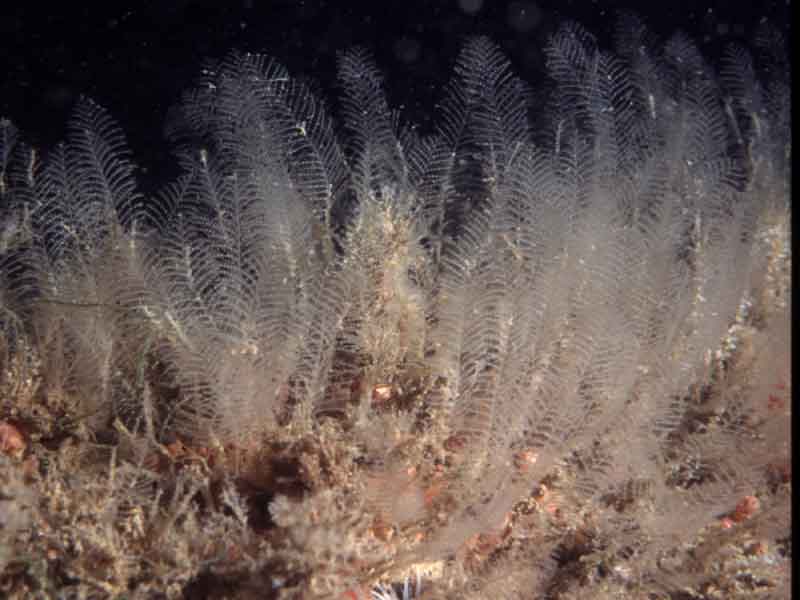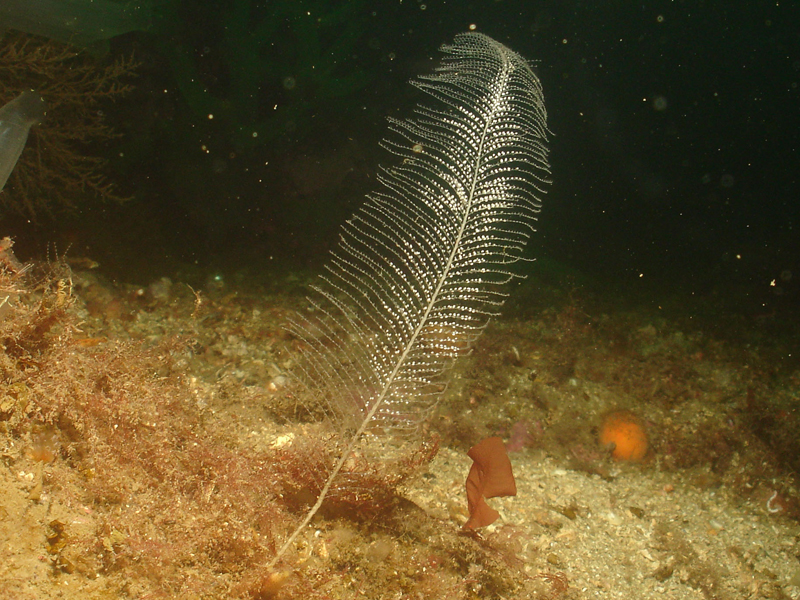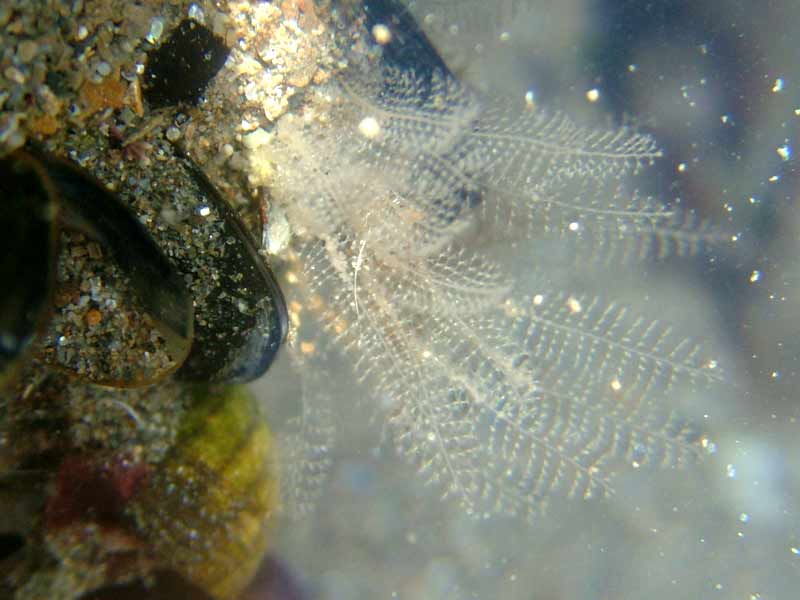Fine feather sea fir (Kirchenpaueria pinnata)
Distribution data supplied by the Ocean Biodiversity Information System (OBIS). To interrogate UK data visit the NBN Atlas.Map Help
| Researched by | Penny Avant | Refereed by | Admin |
| Authority | (Linnaeus, 1758) | ||
| Other common names | Plumed hydroid, Fine feather hydroid | Synonyms | Kirchenpaueria echinulata (Linnaeus, 1758) |
Summary
Description
A colonial hydroid with slender, upright stems that are closely spaced along branching stolons attached to the substratum. They are white to yellowish, typically 3-6 cm, and may be up to 10 cm in height. Branching is pinnate with short, stiff side branches that bear polyps at equal intervals on their inner side in chitinous cups (hydrothecae). The tiny gonothecae are pear-shaped and usually attached to the main stem.
Recorded distribution in Britain and Ireland
Common around all British and Irish coasts.Global distribution
Found in the northeast Atlantic north to Iceland, south to Morocco and also in the Mediterranean.Habitat
Found on rock and a wide variety of other substrata including molluscan and crustacean shells, macroalgae, seagrasses and artificial wooden structures. Intertidal to about 100 m and occasionally to 350 m.Depth range
-Identifying features
- Slender, whitish-yellow stems arising separately, yet clustered, from a branching stolon that is attached to the substratum.
- Stems are monosyphonic, branched pinnately and typically 3-6 cm in height.
- Side branches are short and stiff and bear the hydrothecae, which hold the polyps, at equal intervals along their inner side.
- The hydrothecae have a smooth rim.
- The gonothecae are pear-shaped and touching in a double row attached to the main stem.
Additional information
-none-Listed by
- none -
Bibliography
Cornelius, P.F.S., 1995b. North-west European thecate hydroids and their medusae. Part 2. Sertulariidae to Campanulariidae. Shrewsbury: Field Studies Council. [Synopses of the British Fauna no. 50]
Fish, J.D. & Fish, S., 1996. A student's guide to the seashore. Cambridge: Cambridge University Press.
Hayward, P., Nelson-Smith, T. & Shields, C. 1996. Collins pocket guide. Sea shore of Britain and northern Europe. London: HarperCollins.
Hayward, P.J. & Ryland, J.S. (ed.) 1995b. Handbook of the marine fauna of North-West Europe. Oxford: Oxford University Press.
Howson, C.M. & Picton, B.E., 1997. The species directory of the marine fauna and flora of the British Isles and surrounding seas. Belfast: Ulster Museum. [Ulster Museum publication, no. 276.]
Datasets
Centre for Environmental Data and Recording, 2018. Ulster Museum Marine Surveys of Northern Ireland Coastal Waters. Occurrence dataset https://www.nmni.com/CEDaR/CEDaR-Centre-for-Environmental-Data-and-Recording.aspx accessed via NBNAtlas.org on 2018-09-25.
Fenwick, 2018. Aphotomarine. Occurrence dataset http://www.aphotomarine.com/index.html Accessed via NBNAtlas.org on 2018-10-01
Kent Wildlife Trust, 2018. Biological survey of the intertidal chalk reefs between Folkestone Warren and Kingsdown, Kent 2009-2011. Occurrence dataset: https://www.kentwildlifetrust.org.uk/ accessed via NBNAtlas.org on 2018-10-01.
Manx Biological Recording Partnership, 2022. Isle of Man historical wildlife records 1990 to 1994. Occurrence dataset:https://doi.org/10.15468/aru16v accessed via GBIF.org on 2024-09-27.
National Trust, 2017. National Trust Species Records. Occurrence dataset: https://doi.org/10.15468/opc6g1 accessed via GBIF.org on 2018-10-01.
NBN (National Biodiversity Network) Atlas. Available from: https://www.nbnatlas.org.
North East Scotland Biological Records Centre, 2017. NE Scotland other invertebrate records 1800-2010. Occurrence dataset: https://doi.org/10.15468/ifjfxz accessed via GBIF.org on 2018-10-01.
OBIS (Ocean Biodiversity Information System), 2025. Global map of species distribution using gridded data. Available from: Ocean Biogeographic Information System. www.iobis.org. Accessed: 2025-08-08
South East Wales Biodiversity Records Centre, 2023. SEWBReC Marine and other Aquatic Invertebrates (South East Wales). Occurrence dataset:https://doi.org/10.15468/zxy1n6 accessed via GBIF.org on 2024-09-27.
Citation
This review can be cited as:
Last Updated: 11/04/2002






